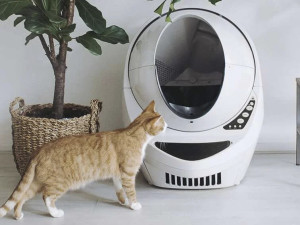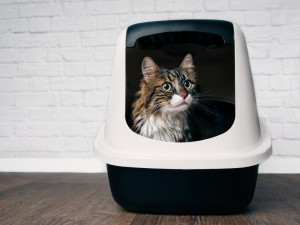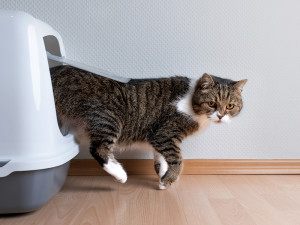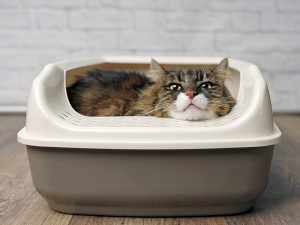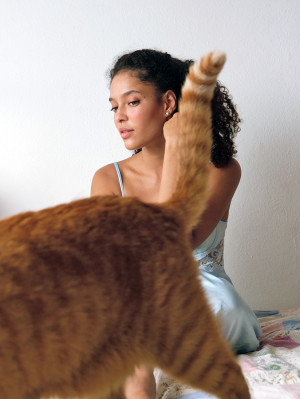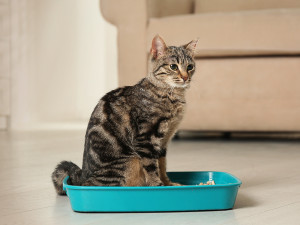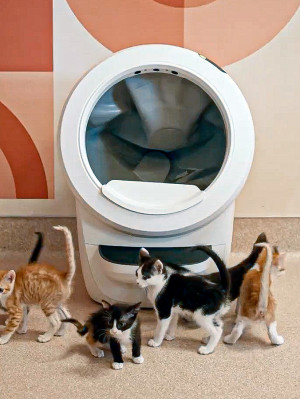Should You Train Your Cat to Use the Toilet?
This is not Meet the Parents.
In This Article:
Can Cats Be Toilet Trained? Should Cats Be Toilet Trained? How Should a New Cat Be Potty Trained? Frequently Asked Questions
Hold on to your hat, because you may have strong opinions regarding what you’re about to read. So, here’s the short version: Cats can be trained to use the toilet (i.e., the commode made for humans), but that doesn’t mean they should. And unpopular opinion alert: There are several reasons not to toilet-train your cat and stick with a good old litter box instead.
Cats can be toilet trained, but it can be stressful for them and discourages natural behaviors like digging and covering waste. Additionally, it could lead to confusion and peeing in the house if the toilet environment changes, or if they simply decide that using the toilet just isn’t for them anymore (i.e., if arthritis is preventing them from jumping up onto the toilet seat safely).
Just because an animal can be trained to do certain things, doesn’t mean that they should. I mean, smaller dogs could potentially use the toilet too, but doesn’t that sound ridiculous? And before you get too mad at me (I’ve read other articles about toilet-training cats and the comments that follow), I know that there are exceptions to the rule - I’ve had clients whose cats have “toilet-trained themselves.” But rest-assured: Even if your cat is using the toilet now without a problem, it doesn’t mean that will always be the case.
How much do you spend on your pet per year?
Can cats be trained to use the toilet?
Of course you can train your cat to use the toilet. Cat toilet-training has been around for a while now, and there are even kits sold for this very purpose. A couple of things that are much harder to train your cat to do include lifting up the toilet lid so they can use the toilet, as well as flushing the toilet (à la Jinx from Meet The Parents fame). And it’s not advisable to teach kittens how to use the toilet (especially since young ones are still learning how to move and balance).
What are cat toilet training kits?
Cat toilet-training kits are a series of round bowls with increasingly large holes in the center of them that you put inside the toilet seat. The first bowl usually doesn’t have a hole — it’s filled completely with litter so that your cat learns that the litter box now sits on the toilet. Then, the next bowl is introduced, with a small hole in the center; the cat can still use litter (or at least dig and bury) in the ring part of the bowl, but as the hole in the center gets bigger with each progressive bowl, the cat will start to pee or poop in the toilet instead of in the ring. Finally, you take the ring away and voilà! Your cat is now using the toilet. In theory, at least.
Should you train your cat to use the toilet?
While you may be able to come up with a few reasons to toilet train your cat, we’ve come up with several reasons not to. Please weigh the pros and cons carefully!
Health monitoring
In my opinion, this is one of the most important reasons for sticking with a litter box. Often, the first indicator that there’s a medical issue happening is when something changes in the litter box, including the frequency and amount of urine being expelled from the cat (which manifests in a changed number of clumps and clumps of a different size in the litter box).
If your cat is using the toilet, of course you’ll be able to see poops, but if your cat is dealing with a medical issue like kidney dysfunction, cystitis, diabetes, or is getting a blockage (which can quickly become fatal in male cats), you’re going to have a hard time seeing changes in urination frequency and amount in the toilet.
Natural behavior
Next, having a cat use the toilet takes away the cat’s ability to express its natural instincts of digging and buryingopens in new tab, which are done to “hide” from predators. If a cat is unable to do this, they may feel more exposed (instinctually, even if there are no other predators in the house), which can increase stress.
Additionally, having a litter box is a big source of scent for cats, who feel more secure in their territory when they can smell themselves (which is not a pass to have a dirty litter box, fyi — cats can smell themselves even if you keep it sparkling clean). Eliminating in water takes this scent source away, which can potentially increase territorial insecurity.
Stress and anxiety
Cats need a safe and reliable place opens in new tab to go. If accessing the toilet is difficult or if there’s been an accident where the cat has fallen into the toilet, that could cause a cat to become fearful of that location and stop using the toilet. Additionally, a cat who is already under stress or who is anxious may decide that using the toilet is just too stressful to continue.
Availability of facilities
And then there’s human error: doors get closed accidentally, or the toilet lid gets closed, or the seat gets left up. Further, as your cat ages, they will likely develop some form of joint pain, which will make accessing and posturing on the toilifficult.
Peeing and pooping in inappropriate places
All of the above issues can result in the same thing: cat peeopens in new tab where you don’t want cat pee to be. If there’s no litter box option for your cat when they decide the toilet is not an acceptable place to pee (whether it’s an off-day, or they’re just over it entirely), I can assure you that you won’t like where they choose to go. So please, if you do choose to toilet-train your cat, always have a litter box back-up that is accessible to your kitty, just in case!
Is there any reason to toilet-train a cat?
I’ll be honest, cleaning out the litter box is not my favorite chore. So there’s one up-side to toilet-training a cat; all you have to do is flush the toilet. Also, no more litter scatter — in fact, say goodbye to litter completely (unless you heed my advice and keep a box around just in case). And no, before people suggest it, I don’t work for or receive money from the cat litter industry. I have had my share of clients who toilet-trained their cats who needed help getting their cat back to using the litter box once the toilet was abandoned… just sayin’.
How should a new cat be potty trained?
There’s not a whole lot to cat potty-training — just show them where the litter box is, and they’ll pretty much do the rest according to instinct. Young kittens start using the litter box at around three weeks of age, and they can be encouraged to use a small litter box with lower sides by placing them in the box after a meal, when their bladder and tummy are full. A little positive reinforcement always helps, too!
The bottom line is that it’s your choice when deciding if toilet-training your cat is a good idea for your home and family. But ultimately, your cat will make the decision about whether the toilet — or a litter box — is the best choice for them. I personally don’t want to risk my slippers being used as a make-shift litter box (in the absence of one), so I’ll stick with the traditional litter box method for my cats.
FAQs (People also ask):
When is it too late to train your cat to use a litter box?
It’s never too late to train your cat to use a litter box. Cats come from all different situations and some of them never learned how to use a proper litter box, but there are various methods for litter box training. If you’re having trouble, reach out to a qualified behavior professional.
Why shouldn’t you toilet-train your cat?
Toilet-training your cat has many drawbacks including not being able to monitor your kitty’s pee and poop (which can indicate serious health problems), denying them their instinct to dig and bury after doing their business, increasing their stress and anxiety, and potentially resulting in unwanted accidents.
What should I do if my cat isn’t using the litter box?
If your cat isn’t using the litter box it’s best to swing by your veterinarian’s office first to rule out any health issues, and then make sure that your litter box setup is up to your cat’s standards. They may not like the box location, the box size (bigger is better!), litter material, sharing the litter box with other cats, or how clean you keep the box (or not, as the case may be).
What is the best cat litter?
The best cat litteropens in new tab is the one that your cat will use! Generally, cats prefer a fine-grained, unscented clumping clay litter that is scooped regularly.


